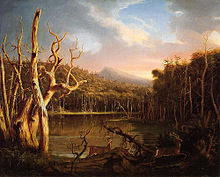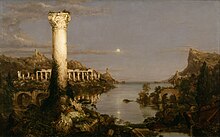Thomas Cole
Thomas Cole (born February 1, 1801 in Bolton , Lancashire , † February 11, 1848 in Catskills, New York ) was an American painter born in England. He is considered to be the founder and most important representative of the Hudson River School , a group of American artists in the mid-19th century who became known for the precise, detailed reproduction of American landscapes, often combined with historical and allegorical subjects.
Life
In his youth in England, Cole learned to make wooden printing blocks that were used to print calico . In 1818 the family emigrated from their home in northwest England to America and settled in Steubenville , Ohio . Thomas initially stayed alone in Philadelphia for a year . After that he moved to Steubenville to his family and worked with in the wallpaper manufactory of his father. He learned the basics of the painting technique with oil paints from a wandering portrait painter named John Stein, but was not very successful in his specialty and soon made his first attempts at landscape painting . In 1823 he followed his family to Pittsburgh , where he also worked in his father's business and made systematic landscape studies in his free time. In doing so, he developed the precise working technique that became the basis of his later landscape painting.
In 1823/24 Cole stayed again in Philadelphia. Here he studied landscape paintings intensively at the Pennsylvania Academy of the Fine Arts and decided to become a professional painter . In 1825 the company moved to New York, where parents and sisters now lived. The merchant George W. Bruen noticed the young painter and financed a study trip along the Hudson River to the Catskill Mountains in September and October 1825. Cole exhibited three small-format oil paintings based on sketches from this trip in a shop window . There she was noticed by John Trumbull , who was influential in the New York art world , painter and long-time president of the American Academy of Fine Arts , who put the young colleague in touch with the city's most important artists and patrons . When Cole decided in 1829 to get to know the masterpieces of the past in the original in Europe, he was already a founding member of the National Academy of Design (an artists' association founded in 1826 that organized annual exhibitions of contemporary American artists and is based in New York City and still exists today) and recognized as a major American landscape painter.
In Europe he continued his education in the museums of London, Paris, Florence, Rome and Naples. Especially his stay in Italy brought him closer to idealistic topics and ideas. As a typical representative of Romanticism , he also sought to express moral values in his landscape painting and to deal with topics that were previously reserved for history painting . On his return in November 1832, he found an understanding patron in the New York merchant and gallery owner Luman Reed . From August 1841 to July 1842, Cole went to Europe again, visited relatives in England and toured France, Italy and Switzerland. During the trip he perfected his painting technique, especially the coloring and rendering of the sky and clouds. Within the United States, Cole traveled to the Adirondacks , a mountain range in northeastern New York in 1846 , and to Niagara Falls in 1847 .
Since 1825, Cole regularly visited Catskill, New York State. He was fascinated by the landscape of the Catskill Mountains and found that the mountains "rise from the valley of the Hudson like waves in an ocean when the storm subsides". During the summer months, the painter lived and worked in the outbuildings of an extensive farm called Cedar Grove . It was here that a significant part of his oeuvre was created. In November 1836 he married Maria Bartow, a niece of the farm owner, and has lived there continuously ever since. However, he always kept in close contact with the art scene in New York City, with artists, collectors and writers who also frequently visited him in Cedar Grove. The landscape painters Asher Brown Durand (1796–1886) and Frederic Edwin Church (1826–1900), who was his pupil between 1844 and 1846, were among his close colleagues . The Cole couple had three sons and two daughters. In 1842 Thomas Cole decided to join the Episcopal Church and was baptized in the St. Luke parish in Catskill. After a brief, severe respiratory illness, he died on Friday, February 11, 1848. Because of the extremely cold weather at the time, only a few of his friends were able to attend the funeral.
Cedar Grove was listed as a National Historic Site in 1999 and has been open to the public after renovation since 2001, the 200th year since Cole was born. In honor of the painter, the fourth highest mountain in the Catskill Mountains is named Thomas Cole Mountain .
Thomas Cole was since 11 February 1822 Member of the Association of the Freemasons , his Loge Amity Lodge No. 5 , is based in Zanesville, Ohio .
plant
Cole extolled the value of the landscape itself, the spiritual values inherent in its beauty. The Catskill Mountains (in addition to impressions from Italy and the White Mountains , which lie northeast of the Catskills) offered him the preferred motifs for his numerous pure landscape paintings as well as for the depictions with an explicitly allegorical or historical background. For him, nature and religion were inextricably linked. He criticized the development of modernity and accused his contemporaries of no longer paying attention to simplicity and beauty. In an essay he stated: "Our society only seeks to achieve something instead of enjoying something ...". In a letter to the art collector Robert Gilmore Jr. in Baltimore in 1826 he wrote: “When the imagination is captivated and only what we can see is described, then in poetry as in painting it is very seldom that something truly great emerges . "
For Luman Reed, Cole painted the five-part cycle entitled The Course of Empire (completed in 1836), which is one of his most famous works. The images depict the development of a civilization from barbarism through its heyday to dissolution and decline in slightly different landscape sections. The contemporary critics rejected the series for formal reasons. Today the view is expressed that it was not a promising idea to show the inevitable end of a society in addition to the rise in the still young United States. Most clients, however, preferred directly recognizable American landscapes anyway, which Cole also supplied them. Although he often emphasized that he was less fond of painting such pictures, these purely realistic landscape paintings are considered to have the same artistic quality as his generally better known works with religious or allegorical accents.
The Departure and The Return , two fantasy landscapes , were created in 1837 . Cole had already painted another pair of thematically related pictures in 1828 with The Garden of Eden and Expulsion from the Garden of Eden , in which he expressed his fears about the impending destruction of nature. Other allegorical landscapes are Dream of Arcadia (1838) and The Architect's Dream (1840). There is also the four-part series The Voyage of Life from 1842, available in two versions , which is also one of Cole's particularly well-known works. A journey on the river of life through the four phases of human life as a child, adolescent, adult and old man is depicted, each guided by a guardian angel . The landscape is shown in moods of the four seasons. As usual in Cole's pictures, people or animals are depicted very small, landscape and sky dominate the scene and play the main role.
The Voyage of Life
Buildings and texts
Occasionally, Cole worked as an architect without any training in the field. In 1836 he took part in a competition for a government building in Columbus, Ohio , and won third prize. The finished building then contained elements from the designs of the first three award winners, but was primarily similar to Cole's contribution. After the church building of the Episcopalian St. Luke Congregation in Catskill was destroyed in a fire, the new building was built according to a design by Cole.
In the 1840s, New York newspapers and magazines published letters and poems by Cole. He wrote detailed diaries and authored a highly regarded essay on the landscapes of America ( Essay on American Scenery , 1835). In it he paid tribute to the beauties of untouched nature. He found the landscapes of Europe reflected the devastation caused by civilization, for which entire forests had been cleared, mountains removed and rivers diverted. On the other hand, he saw the wilderness of America as a manifestation of God's grace and lamented that the signs of progress were gradually becoming visible here too.
literature
(all texts in English)
- Cole, Thomas. The Collected Essays and Prose Sketches . Edited By Marshall Tymn. St. Paul, Minnesota: The John Colet Press, 1980.
- Myers, Kenneth: The Catskills: Painters, Writers, and Tourists in the Mountains, 1820-1895 . Yonkers, New York: Hudson River Museum of Westchester, 1987, 1988. Distributed by University Press of New England, Hanover.
- Noble, Louis Legrand: The Life and Works of Thomas Cole. Edited by Elliot S. Vesell. Hensonville, New York: Black Dome Press, 1997 (reprint).
- Parry, Ellwood C., III: The Art of Thomas Cole: Ambition and Imagination . Newark, Delaware: University of Delaware Press, 1988.
- Robinson, Christine T: Thomas Cole: Drawn to Nature. With essays by John Stilgoe, Ellwood C. Parry III, and Francis F. Dunwell . Albany, New York: Albany Institute of History and Art, 1993
Web links
- Contains biographical information about Thomas Cole and describes the collection of his papers (letters, diaries, notebooks, essays and poems) that is kept in the New York State Library.
- Thomas Cole's Journal with handwritten entries from November 5, 1834 to February 1, 1848. Digitized by the New York State Library (English).
Individual evidence
- ↑ http://www.artchive.com/artchive/C/cole.html
- ↑ nationalacademy.org: Past Academicians / Cole, Thomas Founder NA 1826 ( Memento of the original from March 20, 2016 in the Internet Archive ) Info: The archive link has been inserted automatically and has not yet been checked. Please check the original and archive link according to the instructions and then remove this notice. (accessed on June 18, 2015)
- ↑ http://www.artchive.com/artchive/C/cole.html
- ↑ http://www.thomascole.org/history-of-cedar-grove/
- ↑ 10,000 Famous Freemasons by Denslow, William R .; Truman, Harry S. (2004) from A to J. Kessenger Publishing LLC. Kessenger Publishing LLC. ISBN 1-4179-7579-2 (Retrieved October 23, 2012)
- ↑ http://www.explorethomascole.org/tour
- ↑ http://hoocher.com/Thomas_Cole/Thomas_Cole.htm
- ↑ http://www.artchive.com/artchive/C/cole.html
- ↑ http://hoocher.com/Thomas_Cole/Thomas_Cole.htm
| personal data | |
|---|---|
| SURNAME | Cole, Thomas |
| BRIEF DESCRIPTION | American painter |
| DATE OF BIRTH | February 1, 1801 |
| PLACE OF BIRTH | Bolton , Lancashire |
| DATE OF DEATH | February 11, 1848 |
| Place of death | Catskills, New York |








